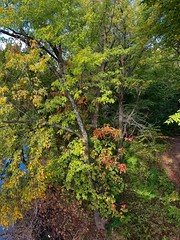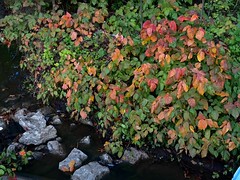After breakfast at the hotel I drove south to Chama, New Mexico to board the Parlor Car of the Cumbres & Toltec Scenic Railroad to ramble back and forth 11 times across the border between New Mexico and Colorado, at a maximum grade of 4 percent and peak speed of about 24 mi/h, from Chama to Antonito, Colorado. The narrow gauge railway rises from an altitude of 7,864 feet at Chama to 10,015 feet at Cumbres Pass, and back down to 7,888 feet at Antonito and extends 64 miles.
Here’s the movie trailer for the ride I made from my experience.
The length of trip makes a round trip by train impossible in a day, so I’d be riding a bus for the return journey, which is then only 48 miles and takes one hour.
Upon boarding I noticed the African mahogany wood interior, pretty light fixtures, and that a fellow in a big black Stetson hat who looked like he walked out of an old western would be seated near me. I commented on his appearance and his wife assured me that he always dresses that way!
Then Chatterbox came in and sat beside me. I don’t know his name and he doesn’t know mine, but I know a great deal about Chatterbox and his interests. The good news was that he is a railroad buff who has memorized facts about all sorts of train engines and entertained me with loads of trivia about them on our journey, and reinforced that I should be sure to drive the San Juan Skyway highway loop this weekend. And he pointed out a few things the guides did not, and helped me get some interesting tunnel shots.
The bad news is that he was garrulous, forcing me to flee from the parlor car regularly to escape, although that was a good thing since I was happiest out on the open Cumbres Vista car to admire the scenery, although the soot and smoke did sometimes make my eyes burn. The only time I got really irritated with Chatterbox, although I never showed it, was when he attached himself to me for the bus ride, talking non-stop the entire hour about everything from bombers and cargo planes and guns (he is an Air Force veteran who was working in a missile silo during the Cuban Missile Crisis) to more entertaining tales of family car mishaps in the area mountains.
But I’ll stop chattering on about Chatterbox and get the train rolling. Engine 489 blews its whistle, a Santa Fe whistle donated by the late chairman of that railroad, who claimed it sounded better than those of the Denver & Rio Grande Western. He was right. I tried repeatedly to capture it with my camera’s movie mode, but never managed to time it right.
The engine poured black coal smoke as we struggled upward across the Lobato trestle. The steepest grade, about 4 percent, is on this side of the continental divide while the steepest grades on the other side are only 2 percent. Sand is sprayed onto the tracks in front of each drive wheel, but as my students should know, steel on steel provides a lower coefficient of friction than rubber on asphalt, so this railway would make numerous winding switchbacks to maximize the normal force on the track. And no, I did not mention any of this to Chatterbox – he was too busy talking about the sand dome and gradients, and his hearing aide was too weak, to let me talk about mu and the rest. And truthfully I did enjoy and benefit from his train expertise.
Out on the Vista car everyone leaned and skittered back and forth from one side to the other, looking like the Star Trek bridge crew careening about as a Klingon attack rocks the Enterprise back and forth. Now and then rock cuts coasted by, having been blasted out in the late 1800s with black powder, picks, mules, and sweat.
We shook and rattled our way down long valleys carved by glaciers and then made a long looping approach to Windy Point, where the rails are laid on a rock shelf carved out from the cliff face. That smudge on the left of the photo is coal smoke, and sometimes the view was obscured and my lungs afflicted.
Jagged rocks stuck out of the ground and then we rode the rock shelf around Windy Point with a panoramic view of the Rio Chama valley. We stopped at Cumbres Pass to take on water. Up here snow drifts 20 feet or more, and railroad families used to live here throughout the winter. And I thought eight snow days this past school year was bad…
Not suprisingly, fire from coal embers is of great concern. Throughout our journey we were shadowed by a fire speeder and while at Cumbres Pass it was backed up to put out a fire the train had started by the tracks. This railroad was partially shut down recently when its Lobato Trestle 100 feet above Wolf Creek was heavily damaged by fire. Thankfully it was repaired so my journey today was complete. Oh, and I had to laugh when during the lunch stop at Osier I spotted the workman manning the fire speeder sitting there…smoking a cigarette. At least he would be able to put it out most effectively!
The train did a couple of blow-offs after we began our descent – it helps clear impurities from the water out of the tanks. We traversed the lovely valley of the Rio de Los Pinos, with me snapping a panorama and admiring a pretty pond. We passed a watering tower and then our track curved so much my panorama had both ends of the train visible in it as we steamed under clouds.
We crossed Cascade Creek atop a 137 foot high trestle, the highest on the line, and I watched its wooden ties pass under us. The River of the Pines wound away into the distance as we approached Osier. This former toll station on a road from Conejos to Chama was once a small community, and our conductor was born there amidst this mountain scenery. We would be stopping in for lunch.
The choice was turkey and dressing or meat loaf, and if you know me then you know I love gobbler. The meal was served cafeteria style and was delicious. Afterward I took a look at the restored old station building, section house where the foreman and his family once lived, as well as today’s fire speeder and one from yesteryear. It may look too small, but remember this is a narrow gauge railway with rails only three feet apart.
The Vista Car was empty for once beneath a lowering sky, but we had no rain. The train from Antonito pulled in for lunch, pulled by Engine 487, and the Stetsoned passenger posed by it. An hour after the other train arrived, we left Osier, and as we steamed away we could see the other train making its way toward Chama.
We passed some truly formidable countryside as we drew toward Toltec Gorge, with the Rio de Los Pinos flowing 600 feet below the rails and with the opposite rim 800 feet away. The edge of the gorge has a stone monument the railroad ticket agents erected in memory of President Garfield a week after his assassination in 1881.
At Chatterbox’s urging, we dashed to the back of our car, which was also the end of the train, to shoot photos of the interior of Rock Tunnel, which bores 360 feet through solid rock. I caught images as we entered the tunnel, curved through it, approached the exit, and left it behind. Thanks, Chatterbox!
We passed two formations which railroad employees call the father and daughter rocks. The railroaders are evidently imaginative (and bored), and it looked to me like pops was advising his offspring that beauty isn’t everything.
We steamed by Toltec Creek and the Calico Rocks, where crews had recently spent several hours clearing the track. Next was Phantom Curve, where the trains wind amidst odd formations called hoodoos. I can imagine how those riding at night find the shadows as the train lights bounce and jiggle off these formations rather spooky, although if they met what I know of as Hoodoo they’d be truly frightened!
We passed through Mud Tunnel, so named because the soft earth requires wooden supports over its entire 342 foot length. This time I shot video rather than stills. And then we raced away from Toltec Gorge at perhaps 15 mi/hr and rounded a stubborn, enormous squat hoodoo in the midst of the valley. One of its friends stood by the track.
The train eased through a cut and the panoramic view with the train winding its way along reminded me of the High Line on the Durango and Silverton. The forest was thinning out and we stopped at Sublette, an isolated past home for section gangs. Chatterbox pointed out how the main building’s windows had painted curtains on them.
We passed more blasted bluffs, and the trees were growing ever more scarce. The landscape was cedars and sagebrush as we pulled into Antonito and my camera’s battery gave up the ghost. So I switched to my iPhone to capture a water tower amidst the scrub and one of the many little booths along the tracks. These booths look like outhouses, but actually were telegraph stations – the line was built without signals so the trains would stop and the conductors get out and communicate with the dispatcher by telegraph and later telephone. Today they use radio.
I saw one last low trestle as we finished our ride. It is called Hangman’s Trestle because a fellow named Ferguson was convicted for an unknown crime in Antonito and hanged from the bridge by a local posse. Supposedly he wasn’t allowed to be hung in the train yard and the trestle was the only place they could find to hang him high enough that his feet wouldn’t touch the ground. True or not, the area here is so flat the train runs at top speed and Chatterbox informed me they shot scenes of Indiana Jones leaping about atop a train here. The train has been used for a number of movies and commercials over the years.
It was a fun ride and I’m glad that the Durango and Silverton train ride last summer hadn’t jaded me on the beauty this other remnant of the narrow gauge system has to offer. But after the long bus ride back to Chama with Chatterbox, and with my eyes still watering from the soot and smoke, I found the drive back to Pagosa Springs most wearying. At my hotel I washed my face and walked over to a nearby restaurant for a chicken enchilada to get me through several hours of photo and movie editing and blogging.
Tomorrow I hope to sleep in and do a short high-altitude hike at Wolf Creek Pass before heading to Durango.
Click here for a slideshow from this train ride







Is there an email for you? I have a question I wanted to ask you about this trip.
Yes: meador@meador.org